Back Pain in Females: 6 Hidden Causes You Shouldn’t Ignore!
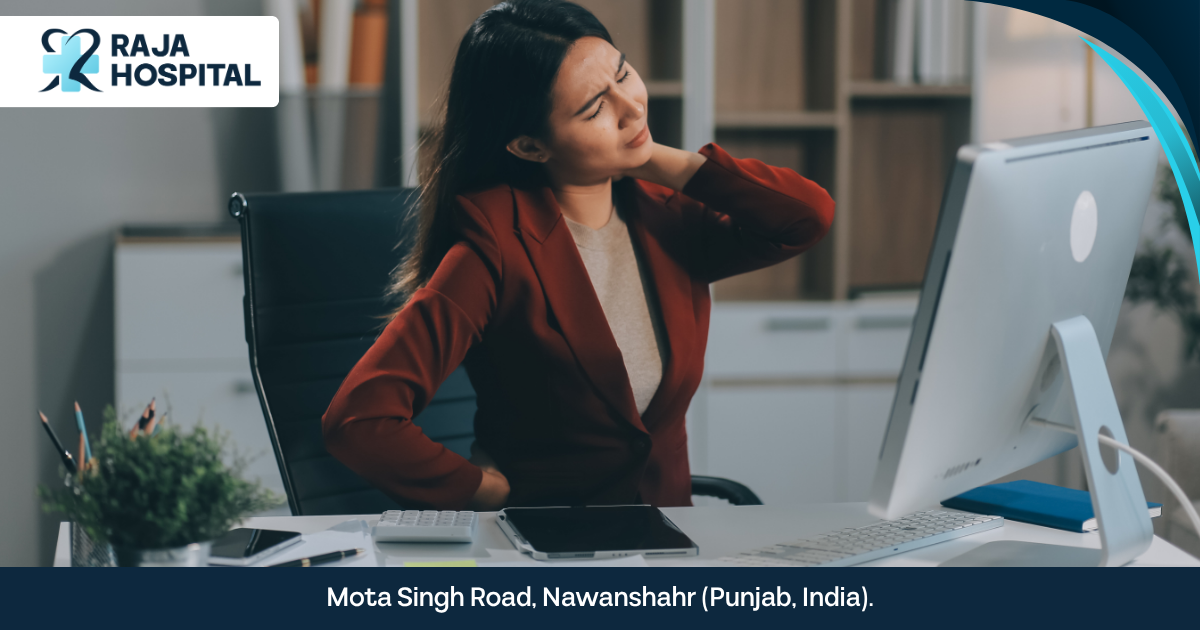
REVIEWED BY Dr. Sunil Duhan (MBBS, D-Ortho) on 8 july 2025.
“It’s just tiredness… I’ll be fine after a good night’s sleep.” Sound familiar?
Most women brush off back pain like it’s just another side-effect of being busy. Whether it’s household chores, long hours at work, or post-pregnancy fatigue, back pain is treated with pain sprays and a shrug.
But here’s the thing: what if it’s not just “normal tiredness”? What if your back pain is a signal? A warning bell that your spine, hormones, or posture are under stress, and ignoring it today might mean a slipped disc or chronic pain tomorrow?
In this blog, we’re diving into 7 warning signs that back pain in women should never be ignored, especially if you’re living a sedentary lifestyle, recovering from pregnancy, or dealing with hormonal changes. I’ll also break down what causes it, how to treat it (beyond sprays and ointments), and when you need to see a specialist.
Your back is trying to talk to you. Let’s finally listen.
The Silent Epidemic: Why Back Pain in Women Goes Untreated

Let’s be honest, most women don’t take back pain seriously. It starts as a dull ache after a long day… and before you know it, it’s a daily visitor.
But here’s the thing: instead of asking why it keeps happening, we often just keep going.
We tell ourselves:
- “Maybe I stood too long today.”
- “It’s probably because I didn’t sleep well.”
- “Let me just apply something warm and relax.”
And while that sounds harmless, it’s exactly why back pain in women often gets ignored for too long.
Why So Many Women Stay Silent
From managing home, work, and kids, women are expected to do it all. So when pain shows up, we think it’s just part of the routine. Something that comes with “doing too much.”
But here’s the truth: your back hurting every day isn’t normal, and brushing it off only delays proper care.
Short-Term Fixes Aren’t Real Solutions
Pain relief sprays, hot bags, and painkillers can help temporarily. But they’re just band-aids. The real problem, whether it’s posture, muscle stress, or something deeper, keeps growing in the background.
Over time, what could’ve been sorted with a small change turns into a full-blown condition that needs medical help.
So if your back has been bothering you more than you’d like to admit, keep reading. Because the reasons might surprise you.
Top 6 Causes of Back Pain in Females (That Aren’t Talked About Enough)
Back pain in women is often misunderstood. It’s not always about lifting heavy things or poor sleep. In many cases, the real reasons are hidden in our daily habits, hormonal shifts, or even undiagnosed conditions.
Let’s break down what could actually be causing your pain:
1. Hormonal Changes
During periods, pregnancy or menopause, hormone levels fluctuate. These changes affect your joints and muscles. A drop in estrogen, for example, can make the ligaments around your spine less flexible. This increases the risk of pain and stiffness, especially around your lower back.
2. Poor Posture
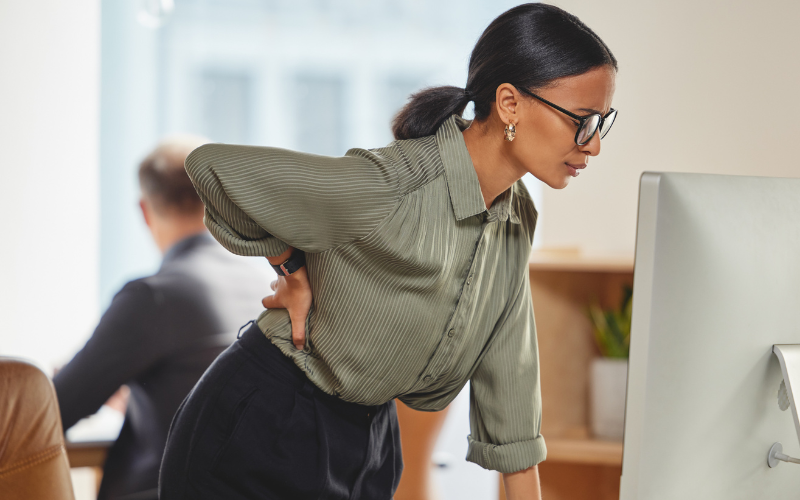
Whether it’s sitting at a desk or bending while doing chores, bad posture adds pressure to your spine. Over time, this leads to chronic discomfort. Most women don’t realize how much stress everyday positions put on their backs until the pain becomes regular.
3. Pregnancy and Post-Delivery Stress
Carrying a baby shifts your body’s balance. Your spine curves more, and your abdominal muscles stretch. After delivery, especially after a C-section, women often resume routines without rebuilding core strength. That weak support causes ongoing pain that doesn’t just go away on its own.
4. Hidden Conditions
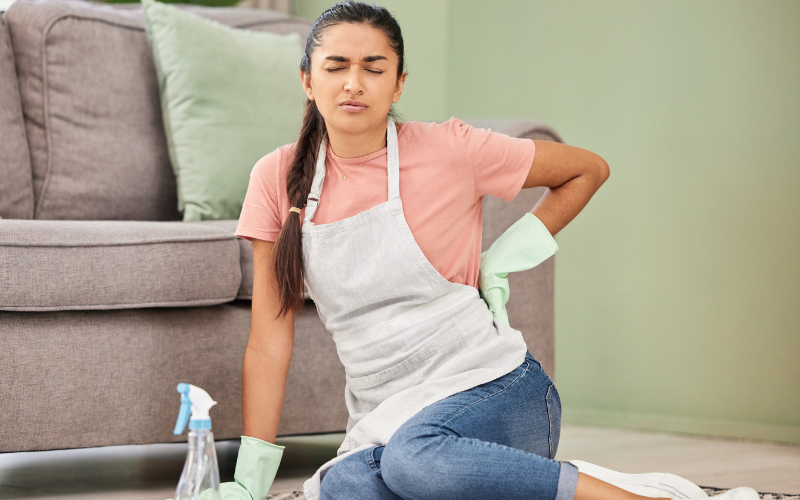
Conditions like slipped discs, sciatica, or even arthritis often go unnoticed until the pain becomes serious. Women tend to ignore early signs, thinking it’s just muscle soreness. But in reality, it could be something that needs proper diagnosis and treatment.
5. Too Much Sitting
If you spend most of your day sitting, your back is missing the movement it needs to stay strong. Sitting weakens your core and tightens your hips, which then pulls on your lower back. This is one of the biggest causes of back pain among working women and stay-at-home moms alike.
6. Emotional Stress
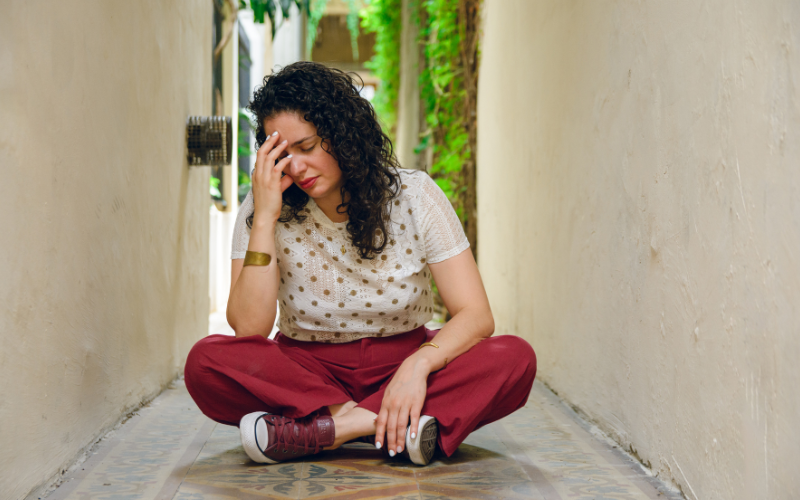
Anxiety, overwhelm, and lack of sleep can show up as physical pain. Stress tenses your shoulders and back muscles. If you carry emotional load without releasing it, your body starts to hold that tension, often in the form of back pain.
When Back Pain Is Not Just Back Pain
Most women believe back pain is something that comes and goes. But what if it’s not just because you’re tired or overworked?
Sometimes, that dull ache or stiffness is a signal that something deeper is going on. Your body has its own way of asking for help. And if you don’t listen early, it starts shouting louder.
How to Know It’s Serious
If your back pain keeps coming back, lasts for weeks, or wakes you up at night, it’s time to pause and pay attention.
Red flags that should not be ignored:
- Pain that keeps returning or lasts more than 2 weeks.
- Pain that travels down your legs or causes numbness.
- Sharp, stabbing, or burning sensations.
- Difficulty standing or walking for long periods.
- Pain that wakes you up at night or worsens when lying down.
Acute vs Chronic Pain
Acute pain is short-term. It shows up after a specific trigger, like lifting something or sleeping wrong. It usually improves with rest or basic treatment.
Signs to look for:
- Acute pain comes suddenly, often after lifting something heavy or bad posture
- Chronic pain lasts for 3 months or more, with no clear reason
- Chronic pain often points to deeper issues like disc problems or nerve compression
How pain affects your mental health
Unresolved pain doesn’t just stay in your body. It affects your sleep, mood, focus, and even relationships. Many women report feeling low or anxious when living with chronic back issues.
The Mental Side of Pain:
- Constant pain can lead to frustration, mood swings, and anxiety.
- Many women feel helpless when pain starts affecting their daily tasks.
- Sleep disturbance due to pain adds to mental fatigue.
Hormones, Hips & Health: The Female-Specific Angle
Back pain in women often connects to what’s happening inside the body. Your hormones, monthly cycles, and health conditions can all affect your spine and muscles more than you might think.
How hormones affect your back
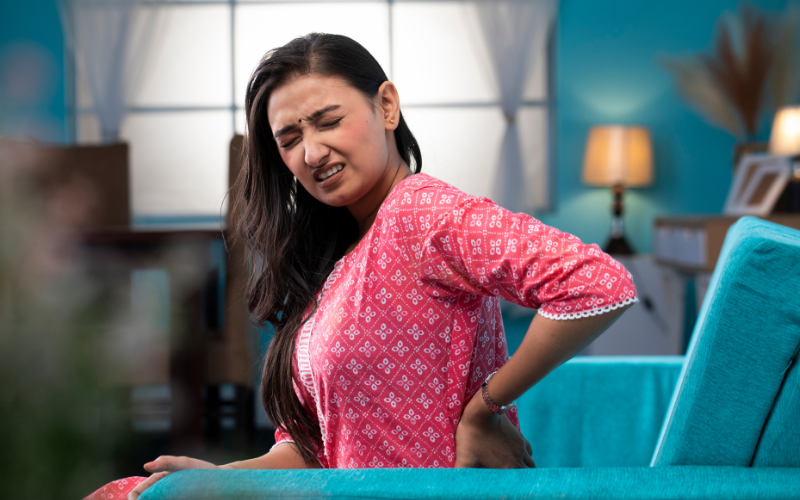
When hormone levels shift, your joints and muscles feel the impact, especially around your spine.
- Estrogen supports flexibility in muscles and joints
- A drop in estrogen makes ligaments less flexible, causing stiffness
- Back pain often worsens before or during your period
- Hormonal changes can also lead to increased inflammation in the body
When periods and back pain go hand-in-hand
Lower back pain during your period isn’t just a coincidence. It has a biological reason.
- The uterus contracts, which pulls on nearby muscles and ligaments
- This creates a dull, aching pain in the lower back
- Intense or long-lasting pain could be a sign of conditions like endometriosis or fibroids
PCOS, thyroid, and hormonal imbalances
Conditions like PCOS or thyroid problems affect hormones, which in turn affect your spine.
- Hormonal imbalance can increase inflammation and water retention
- These issues often lead to fatigue, muscle weakness, and back strain
- The added weight and reduced muscle tone put more pressure on your spine
Menopause and spine health
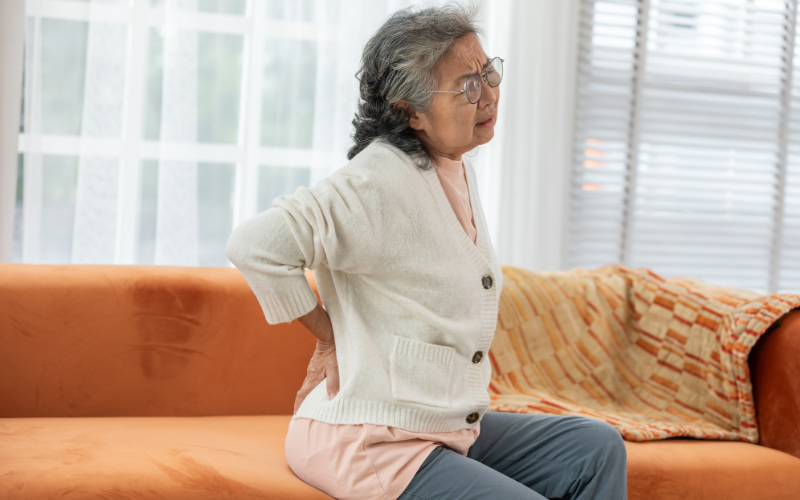
As women approach menopause, several changes increase the chances of back pain.
- Bone density begins to decline, making the spine more fragile
- Lower estrogen levels weaken the muscles supporting the spine
- Many women experience more frequent back pain or stiffness after age 45
Back Pain After Pregnancy – What’s Going On!
Pregnancy changes everything from your posture to your core strength. And if you’re still feeling back pain months after delivery, you’re not alone. There are real physical reasons behind it.
Your body’s center of gravity shifts
Carrying a baby changes how you stand, sit, and walk, which affects your spine.
- The growing belly pulls your pelvis forward, increasing lower back pressure
- Your spine curves more than usual to balance the weight
- These changes often continue even after childbirth if not corrected
Weakened core muscles can’t support the back
During pregnancy, abdominal muscles stretch to make space for the baby.
- Weaker core muscles mean less support for your lower back
- This puts extra load on the spine, especially when lifting or bending
- Without proper post-delivery exercises, the core stays weak for months
C-section recovery is often skipped too soon
Many women try to “bounce back” quickly after a C-section, but the body needs healing time.
- Surgical cuts affect core strength and posture
- Scar tissue can tighten the lower abdomen, affecting movement
- Lack of proper rehab often leads to long-term pain in the back and hips
Pelvic alignment gets disturbed
Pregnancy loosens your pelvic joints, and they don’t always return to their original position.
- Misalignment of the pelvis affects how pressure is distributed on your spine
- This often leads to pain in the lower back, especially when walking or climbing stairs
How to Treat Back Pain (Without Just Relying on Pain Sprays)
Pain sprays may give you quick relief, but they don’t fix the problem. Real recovery comes from treating the root cause. Here’s what actually works when it comes to long-term back pain relief.
Start with strengthening exercises
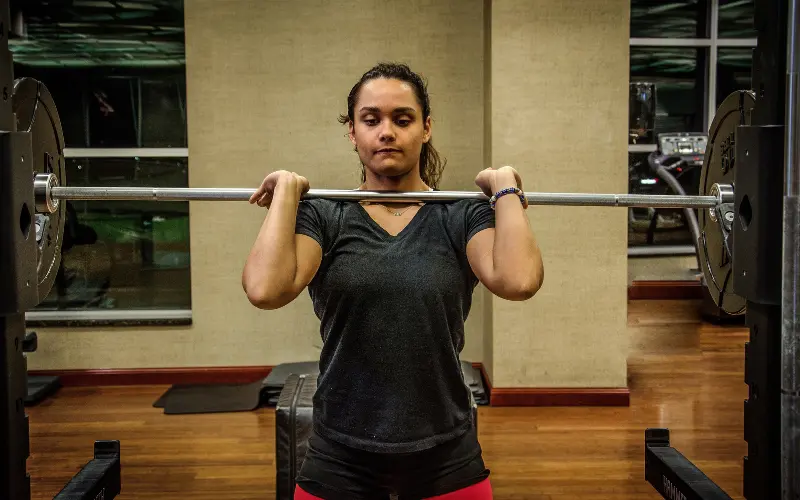
Strong core and back muscles help take pressure off your spine.
- Include pelvic tilts, bridges, and gentle abdominal exercises
- Practice movements that improve balance and stability
- Avoid heavy workouts unless guided by a professional
Fix your daily posture
Bad posture is one of the biggest triggers for back pain, especially for women who sit or bend for long hours.
- Sit with your feet flat, back supported, and shoulders relaxed
- Avoid slouching or crossing your legs for long periods
- Use a small pillow or lumbar roll behind your lower back if needed
Make small ergonomic changes
Your furniture, gadgets, and even kitchen setup can affect your spine.
- Adjust your chair and desk height if you work on a laptop
- Use a step stool in the kitchen to reduce bending
- Choose footwear with proper support
Add physiotherapy or yoga to your routine
Both are effective for long-term pain relief when done consistently and correctly.
- A physiotherapist can guide you through movements that strengthen without strain
- Yoga improves flexibility, balance, and muscle tone
- Start slow and listen to your body
Avoid quick fixes and dependency on sprays
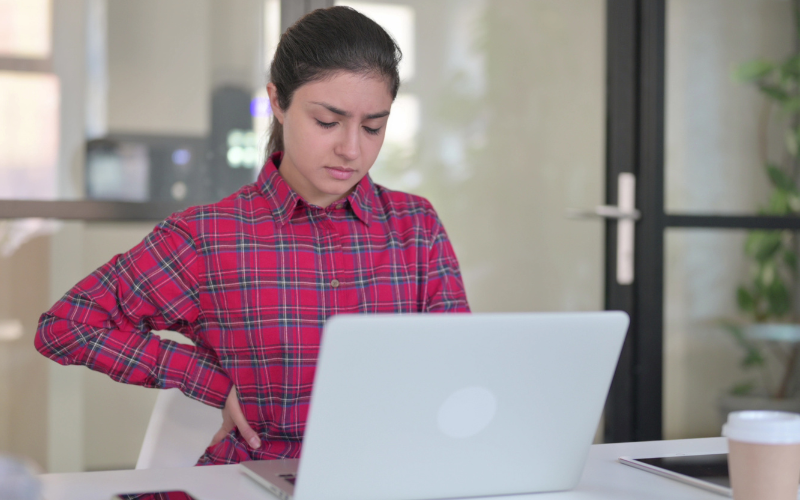
Topical creams or painkillers may help in emergencies, but don’t rely on them every day.
- They only reduce surface-level symptoms
- Using them regularly can delay real treatment
- Focus on healing, not just hiding the pain
When to See a Doctor (And What Happens Next)?
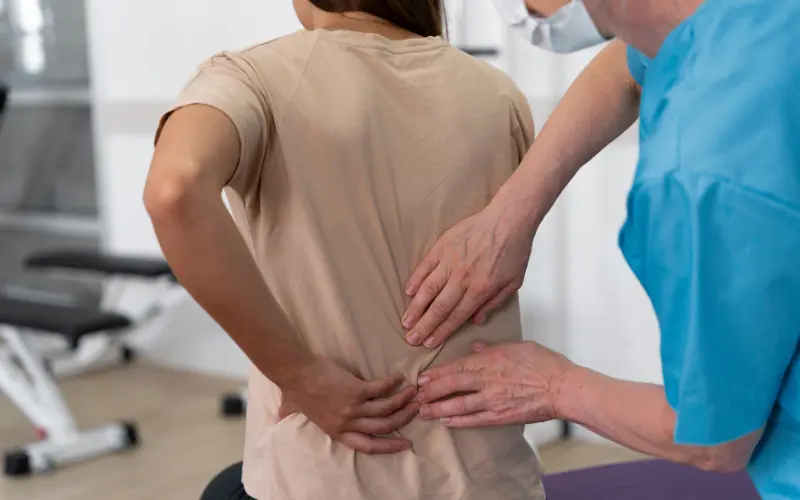
Most women delay seeing a doctor for back pain. It could be because the pain feels bearable, life is too busy, or there’s a belief that it will go away on its own.
But the reality is, some types of back pain should never be ignored. The longer you wait, the more damage it can quietly cause.
So, how do you know it’s time to take action?
If your pain:
- Has lasted more than two weeks
- Interrupts your sleep regularly
- Shoots down your legs or causes numbness
- Started after a fall or sudden movement
- Makes it hard to sit, stand, or walk for long
These are not things to brush off. They are your body’s way of warning you.
Visiting a doctor doesn’t have to be intimidating. A good doctor will listen without judgment. They’ll ask about your symptoms, your lifestyle, and how long you’ve been managing the pain. You might be asked to do simple stretches or movements to assess your range of motion.
If needed, tests like an X-ray, MRI, or blood work may be suggested to get a clearer picture.
The best part is, proper diagnosis leads to personalized treatment. Back pain in women is often linked to hormones, childbirth, and lifestyle patterns. So your care plan should reflect that, not just offer general advice like resting or taking painkillers. Taking this step could be the beginning of lasting relief.
Managing Back Pain with a Sedentary Lifestyle

You don’t need to be a fitness junkie to avoid back pain. Even if you sit for long hours, small changes can protect your spine and ease discomfort.
Let’s look at practical ways to manage back pain when you’re not always on the move.
Rethink your sitting setup
Where and how you sit matter more than you think.
- Use a chair with good back support
- Keep your feet flat on the ground
- Avoid slouching or leaning to one side
- Place a cushion behind your lower back if needed
Take small movement breaks
Your body needs motion, even if it’s just a little.
- Stand up every 30 to 60 minutes
- Stretch your arms, shoulders, and back gently
- Walk around your room or take a quick stroll
Add simple stretches to your day
You don’t need a full workout routine, just consistency.
- Try basic stretches like cat-cow, spinal twists, and hamstring stretches
- Hold each stretch for at least 20 seconds
- Do them in the morning, before bed, or during breaks
Support your spine while sleeping
Your posture at night also affects your back health.
- Sleep on your side with a pillow between your knees
- If you sleep on your back, place a pillow under your knees
- Use a medium-firm mattress and avoid overly soft pillows
These small changes can make a big difference over time. You don’t need to flip your lifestyle upside down. You just need to move smarter and rest better.
Frequently Asked Questions
Is back pain during periods normal for women?
Yes, mild pain is common. But if it’s severe or persistent, it could point to issues like endometriosis or hormonal imbalance.
Can hormonal changes cause long-term back pain?
They can. Drops in estrogen affect joint flexibility and muscle strength, leading to back discomfort.
What can I do to manage back pain at work?
Fix your posture, use proper back support, and take short movement breaks every hour.
Is it normal to have back pain after a C-section?
Yes. Weak core muscles and pelvic changes are common after surgery. Strengthening exercises can help.
Can stress really make back pain worse?
Definitely. Stress causes muscle tension, which often shows up as back or neck pain.
Struggling with same?
Book Your Appointment With Our Expert Doctors

Conclusion: Stop Normalizing Your Pain. Start Healing It.
Back pain is common in women, but that doesn’t mean it should be ignored. The more you delay addressing it, the worse it can get. Every day, tasks start feeling heavier, and your body keeps asking for help.
Whether the cause is hormonal, related to childbirth, poor posture, or a sedentary lifestyle, your back is constantly sending signals. The question is, are you paying attention?
You don’t have to live with discomfort. You don’t have to depend on pain sprays or temporary fixes. And you definitely don’t have to wait until the pain becomes impossible to manage.
Make small changes. Adjust your habits. And when the pain lingers, speak to a doctor who understands what your body is going through. Your back supports your entire day. It’s time to support it again.
Back pain isn’t just uncomfortable, it’s a sign your body needs care. Let our doctors at Raja Hospital help you find the cause and fix it before it worsens.
